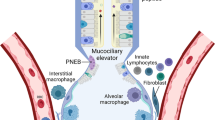Abstract
The rapid innate immune response to respiratory infection is essential to prevent the systemic dissemination of pathogens. This chapter outlines an experimental mouse model of respiratory infection by gram-negative Pseudomonas aeruginosa and analyses of leukocyte trafficking in the lungs. The reader will learn two methods to induce respiratory infection in mice that differ in whether the initial bolus is targeted within a specific lobe of the lung. We then describe a technique based on tissue digestion and flow cytometry that allows the investigator to distinguish leukocytes within different compartments of the lung, and discuss the advantages and limitations to such an approach.
Access this chapter
Tax calculation will be finalised at checkout
Purchases are for personal use only
Similar content being viewed by others
References
Lord JM, Midwinter MJ, Chen YF et al (2014) The systemic immune response to trauma: an overview of pathophysiology and treatment. Lancet 384:1455–1465
Fagon JY, Chastre J, Vuagnat A et al (1996) Nosocomial pneumonia and mortality among patients in intensive care units. JAMA 275:866–869
Jones RN (2010) Microbial etiologies of hospital-acquired bacterial pneumonia and ventilator-associated bacterial pneumonia. Clin Infect Dis 51(Suppl 1):S81–S87
Williams BJ, Dehnbostel J, Blackwell TS (2010) Pseudomonas aeruginosa: host defence in lung diseases. Respirology 15:1037–1056
Oishi K, Sonoda F, Iwagaki A et al (1993) Therapeutic effects of a human antiflagella monoclonal antibody in a neutropenic murine model of Pseudomonas aeruginosa pneumonia. Antimicrob Agents Chemother 37:164–170
Koh AY, Priebe GP, Ray C et al (2009) Inescapable need for neutrophils as mediators of cellular innate immunity to acute Pseudomonas aeruginosa pneumonia. Infect Immun 77:5300–5310
Kooguchi K, Hashimoto S, Kobayashi A et al (1998) Role of alveolar macrophages in initiation and regulation of inflammation in Pseudomonas aeruginosa pneumonia. Infect Immun 66:3164–3169
Lee K, Cohen JT, Wilson ZS et al (2018) Hemorrhage attenuates neutrophil recruitment in response to secondary respiratory infection by Pseudomonas Aeruginosa. Shock 52(5):506–512
Grommes J, Soehnlein O (2011) Contribution of neutrophils to acute lung injury. Mol Med 17:293–307
Anderson KG, Mayer-Barber K, Sung H et al (2014) Intravascular staining for discrimination of vascular and tissue leukocytes. Nat Protoc 9:209–222
LaBauve AE, Wargo MJ (2012) Growth and laboratory maintenance of Pseudomonas aeruginosa. Curr Protoc Microbiol Chapter 6:Unit 6E.1
Acknowledgments
This work was supported by the following awards from the National Institutes of Health: R35GM124911 (C.T.L.) and P20GM121344 Project 2 (B.W.L.). All authors declare no related conflict of interest.
Author information
Authors and Affiliations
Corresponding author
Editor information
Editors and Affiliations
Rights and permissions
Copyright information
© 2021 Springer Science+Business Media, LLC, part of Springer Nature
About this protocol
Cite this protocol
LeBlanc, B.W., Lefort, C.T. (2021). A Mouse Model of Pseudomonas aeruginosa Pneumonia. In: Walker, W.E. (eds) Sepsis. Methods in Molecular Biology, vol 2321. Humana, New York, NY. https://doi.org/10.1007/978-1-0716-1488-4_6
Download citation
DOI: https://doi.org/10.1007/978-1-0716-1488-4_6
Published:
Publisher Name: Humana, New York, NY
Print ISBN: 978-1-0716-1487-7
Online ISBN: 978-1-0716-1488-4
eBook Packages: Springer Protocols




